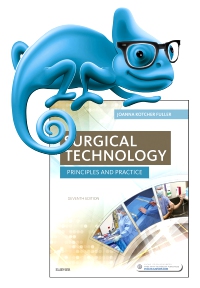
Elsevier Adaptive Learning for Surgical Technology, 7th Edition
Elsevier Adaptive Learning

Corresponding chapter-by-chapter to Surgical Technology, 7th Edition, Elsevier Adaptive Learning combines the power of brain science with sophisticated, patented Cerego algorithms to help students to learn faster and remember longer. It’s fun; it’s engaging; and it’s constantly tracking student performance and adapting to deliver content precisely when it’s needed to ensure core information is transformed into lasting knowledge.
-
- UNIQUE! Individual study schedules reduce cognitive workload and train students to become more effective learners by automatically guiding the learning and review process.
- UNIQUE! Each student’s memory strength is profiled at the course, chapter, and item level to identify personal learning and forgetting patterns.
- A robust educator dashboard offers at-a-glance access to data on individual and group knowledge usage and retention at the course and item level that can be used to modify lectures or class activities accordingly.
- The mobile app offers students a seamless learning experience between their smartphone and the web with memory profiles maintained and managed in the cloud.
- UNIQUE! Material is re-presented just before each student would naturally forget it to counteract memory decay.
- A personalized learning pathway is established for each student based on their learning profile, memory map, and time required to demonstrate information mastery.
- The comprehensive student dashboard allows each individual to view their personal learning progress.
-
PART I: SURGICAL TECHNOLOGY PRINCIPLES
1. The Surgical Technologist
2. Communication and Teamwork
3. Law, Documentation, and Professional Ethics
4. The Health Care Facility
5. The Patient
6. Diagnostic and Assessment Procedures
7. Environmental Hazards
8. Microbes and the Process of Infection
9. The Principles and Practice of Aseptic Technique
10. Decontamination, Sterilization, and Disinfection
11. Surgical Instruments
12. Perioperative Pharmacology
13. Anesthesia and Physiological Monitoring
14. Postanesthesia Recovery
15. Death and Dying
16. Physics and Information Technology
17. Energy Sources in Surgery
18. Moving, Handling, and Positioning the Surgical Patient
19. Surgical Skin Preparation and Draping
20. Case Planning and Intraoperative Procedures
21. Management of the Surgical WoundPART II: SURGICAL TECHNOLOGY PRACTICE
22. Minimally Invasive Endoscopic and Robotic-Assisted Surgery
23. General Surgery
24. Gynecological and Obstetrical Surgery
25. Genitourinary Surgery
26. Ophthalmic Surgery
27. Surgery of the Ear, Nose, Pharynx, and Larynx
28. Oral and Maxillofacial Surgery
29. Plastic and Reconstructive Surgery
30. Orthopedic Surgery
31. Peripheral Vascular Surgery
32. Thoracic and Pulmonary Surgery
33. Cardiac Surgery
34. Pediatric Surgery
35. Neurosurgery
36. Emergency Trauma Surgery
37. Disaster Preparedness and ResponseAPPENDIXES:
A. Common Pathology by System
B. Drugs and Substances Associated with Surgery
C. Math Review
D. Computer Operations
GLOSSARY
INDEX -
This product is available in the following formats:
















 as described in our
as described in our 